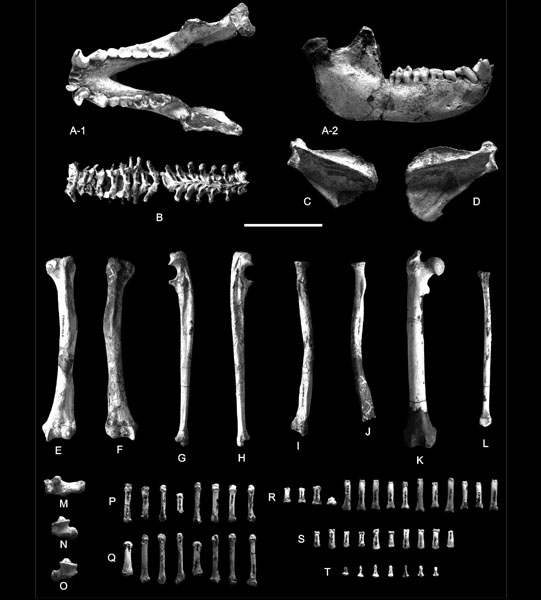A Partial Macaque Skeleton (Mammalia, Primates) Found in Chongzuo, Guangxi, South China
Drs. ZHANG Ying-Qi and JIN Chang-Zhu, Institute of Vertebrate Paleontology and Paleoanthropology, Chinese Academy of Sciences, recently described a partial macaque skeleton (Mammalia, Primates) from Queque Cave, Jiangzhou District, Chongzuo City, Guangxi Zhuang Autonomous Region (22°16′22″N, 107°30′22″E), as reported in the 3rd issue of Vertebrata PalAsiatica.
Queque Cave occurs in Wuming Mountain. The altitude of the entrance is 202 m above sea level. Four field seasons of excavation at the Queque Cave site during 2007?2009 unearthed a large number and wide variety of fossils, representing both large and small mammals. At least two great apes, Gigantopithecus blacki and Pongo sp., and at least three Old World monkey species have been recovered. Nearly all of these primate remains from the Queque Cave are gnathodental, including cranial and mandibular fragments but consisting mostly of isolated teeth. In December 2008, a partial macaque skeleton belonging to an aged male individual and preserving a nearly complete mandible, all 7 cervical vertebrae and 9 thoracic vertebrae, both forelimbs, a part of the right hindlimb, and most of the carpals, tarsals, metapodials and phalanges was unearthed from the sediments of the Queque Cave. This is the most complete skeleton of a fossil macaque so far discovered in China., as five species of fossil macaques previously reported in China: M. anderssoni, M. robustus, M. jiangchuanensis, M. peii and M. youngi. were all established on the basis of craniodental material.
Primary studies show that the Queque Cave macaque is most similar in dental size to M. cf. M. anderssoni from Longdan and Renzidong, and larger than other known fossil species discovered in China. However, there are obvious differences in mandibular morphology between the Queque Cave form and all other known fossil Chinese macaques, apart from the poorly represented M. youngi.
“We tentatively regard the Queque Cave form as an unnamed species of the genus Macaca, taking into consideration the rarity of comparative fossil material and the uncertain phylogenetic relationships among known fossil macaque species in China,” said Dr. ZHANG Ying-Qi, “The Queque Cave skeleton is undoubtedly referable to the genus Macaca based on its dental and mandibular morphology.”

Fig.1: Some specimens of the Macaca partial skeleton from the Queque Cave, Guangxi (Courtesy of Drs. ZHANG Ying-Qi and JIN Chang-Zhu)
Download attachments: